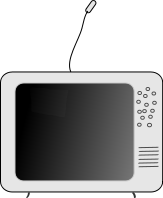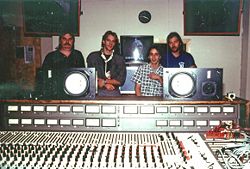The Equalizer (score)
| The Equalizer | |
|---|---|
| Basic information | |
| Created by: | NAME |
| Executive producer: | PRODUCER |
| Soundtrack by: | Stewart Copeland |
| Original network: | ORIGINAL NETWORK |
| Original run: | 1985-09-18 - 1989-08-24 |
| Running time: | XX minutes |
| Number of seasons: | 4 seasons |
| Number of episodes: | 88 episodes |
| Country: | USA |
| Language: | English |
| IMDB link | |
Contents
Plot summary
This section needs more information. Include a brief summary of the plot of this series.
Cast
This section needs more information. Include a list of the primary cast of the series.
Episode list & original airdates
The score
In September 1985 - roughly from September 4 to about September 26 - Stewart Copeland and Jeff Seitz worked on the score of The Equalizer at Unique Recording Studios, before continuing their work at The Hit Factory.
Michael Finlayson was the engineer at Unique Recording Studios with Jeff Lord assisting.
This photo with all four of them was taken in Studio B, but most of the work was done in Studio C (aka "Midi City").
Scoring started a couple of weeks before the Pilot episode was aired (on September 18, 1985).
Michael Finlayson remembers:
"The original Pilot had been scored by Lalo Schifrin, but didn’t work I guess, so they got Stewart. By then they (the producers) had lost most of their lead time so they were literally shooting two weeks before air and we were working on the music the week before air. The show we were working on aired days after we finished. As I recall, I worked on the pilot and the first four shows, but that gets into October.
Once we started the EQ we worked 14 hours a day, seven days a week... We worked EVERY day. I do remember one day off so Stewart could fly down to Florida to play polo. And we took the night off the for the MTV Video Music Awards on September 13.
Stewart asked Jeff (Seitz) to go buy him a shirt to wear, because we were always under the gun and if he was taking the night off, and we were going to meet deadline, there was no way he was leaving the studio. Jeff came back with a shirt. An EIGHT HUNDRED DOLLAR shirt. And this is 1985 dollars. I probably said 'WHAT?!?!" or at least audibly gasped and Stewart turned and said, "That's one thing about making so much money. I've lost track of the value of a dollar. I know the value of a thousand dollars or ten thousand, but not a dollar." That is not an exact quote, but the concept is there. This was proven true a few times when we let Stewart order lunch. We were used to getting a sandwich or meatball hero sent in. Maybe $3. He'd send somebody to a restaurant and then we'd find out when the food came that our share was $20! It was always delicious though. Ha!
Stewart got my wife Lida and I backstage passes for a Sting concert at Radio City Music Hall – Lida also worked at Unique – and also gave us roses at the concert (that I think he ran out and bought on the street.) Nice. No date on the backstage pass. Unless the 4 means the fourth night which would have put it on the 27th – the night of the hurricane (more on that later.)
I don't know if you want to use this, but it was another interesting evening on the project. Stevie Nicks was downstairs in Studio A. She wanted Stewart to come down and play hi-hat on her record. As I recall he was going to blow her off and then he got an idea to have her do her trademark scatting over the intro theme of the Equalizer. "Midi City" had a large control room and a booth maybe 6x6 or 8x8 feet. She agreed. So I set up a mic and a small tv monitor for playback in the dimly lit booth. Meanwhile, Stevie and her assistant (whose main job appeared to be to manage Stevie's alcohol and/or pharmaceuticals) listened to the track in the control room. When I was set, Stevie went in and started singing along with the track. We did multiple takes and she just seemed to be meandering, not really emphasizing or locking in with the visuals. I pushed talkback and Stewart said something to the effect of "just watch the TV and try and highlight the action onscreen." I lifted the talkback and she responded, "What TV?" She was standing in a small dark room with a TV not three feet from her face. I think we called it after that. I don't think Stewart ever made it down to Studio A. The saddest part of this story is that I saved those outtakes, probably on beta-hifi. When beta went the way of the dodo, so did all my old tapes. Wish I had that one back. It actually sounded pretty cool."
It's not (yet) clear at which precise date Stewart moved from Unique Recording Studios to The Hit Factory - Michael Finlayson thinks that Stewart was already working at The Hit Factory when a hurricane hit New York.
"Another clue to the date he moved to The Hit Factory was a hurricane. At one point I thought I might move to The Hit Factory with the project, but in the end I didn’t. However, I was going to go over to The Hit Factory to hang out and see if I could be of any help in the transition. I distinctly remember calling the studio to see if they were going to cancel sessions because of “the hurricane.” When I looked up the 1985 hurricane schedule, believe it or not, there were two that hit NY at the same time. We NEVER got hurricanes in NY. This was very unusual to get ONE, much less two. Anyway, Henri hit eastern Long Island with winds of 40 mph (65km/h) on September 24th. Gloria, which formed and was named earlier, hit later and closer making landfall on Western Long Island September 27th as a Category 2 with winds of 96-110 mph (154-177 km/h.) It is MUCH more likely that Gloria is the storm I was concerned about.
So that’s about as close as I can get on the end date. By the 27th, I am pretty sure he had moved to The Hit Factory."
Michael Finlayson recalls some technical problems of the production:
"I have other assorted stories about the sessions if you’re interested. For instance, when Stewart’s Fairlight arrived we were having all kinds of problems. We had to switch it to US voltage of 110/120, of course, but later realized that although the main instrument didn’t care, the hard drives were spinning at the wrong speed due to the 60 cycle alternating current. I went to high school in Stuttgart and remembered all of my records playing at the wrong speed because the juice over there was 50 cycle and my record player motor was setup for 60. But as of September ’85 I had never thought about computer hard drives having the same problem!
Another Euro/American technical issue we encountered was with video frame rates and timecode. Stewart was used to working with 25fps and in the US we use 30fps. Up to this time we had not done a lot of video work at Unique, at least not that required syncing. I don't think we were even rolling locked 24 tracks at that point. I can't remember the name of the unit we acquired, possibly a Lynx, but I do remember a great deal of fooling around with 25 and 30 fps and then drop-frame and non-drop."
Michael Finlayson: "Stewart autographed a copy of The Rhythmatist for me. “You have the money” was a quote from the first show after the pilot, "China Rain". For some reason it became the catch phrase of the project. When we were tired, or stressed, or in the middle of lunch, or for no good reason at all one of us would turn to the other and say, “But, you have the money….” In the whimpering tone of the actress and it would always send us into hysteria. It makes me smile to even think about it. I have no idea why. You had to be there…"
Release history
This section needs more information. Include a chronological list of various dvd and vhs releases of this series.
| Cover art | Release title | Release date | Country | Format | Language | Special features |
|---|---|---|---|---|---|---|
| RELEASE TITLE | YYYY-MM-DD | Country | Examples: VHS (PAL), VHS (NTSC), DVD (Region #/PAL or NTSC)... | Language | List of any special features |
See also
External links
This section needs more information. Please include links to other websites that provide information about or related to this television series.
References
source: Michael Finlayson



